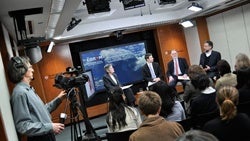March 28, 2011 — People in Japan may look calm on the outside but they are depressed on the inside, a former Harvard School of Public Health (HSPH) research fellow told an in-studio and webcast audience at a panel discussion, “Response to the Earthquake, Tsunami and Nuclear Crises in Japan: Disaster Leadership in Action.” “It’s almost to the boiling point,” said emergency physician Takashi Nagata, who participated in the panel remotely from Tokyo.
Nagata joined other disaster response and radiation experts in a special edition of The Forum at Harvard School of Public Health to discuss the disaster unfolding in Japan. The Forum was recently established by the School to present a platform for experts to share knowledge on health issues, controversies and current concerns to decision-makers around the world.
Nagata told of initially going to Waki City for three days to tend to some of the large number of evacuees housed in 140 emergency shelters. About 30% of the people in the shelters are older and many are “panicked” about not having with them their medicines for diabetes, heart disease and other chronic diseases, he said. After several days, Nagata felt the need to return to Tokyo to hold a press conference with the Japan Medical Association to publicly ask the government for help assisting the stricken region. “People inside [the region] cannot call for help but they need help. I came back [to Tokyo] to describe what happened and to ask for help from outside,” he said.
“I cried three times on Thursday. I became panicked. Every four to six hours new things happened,” Nagata said.
Other participants in The Forum included Gordon Thompson, a radiation expert and executive director, Institute for Resource and Security Studies in Cambridge, Mass.; Michael VanRooyen, founder and director of the Harvard Humanitarian Initiative, associate professor at HSPH, and an emergency physician at Brigham and Women’s Hospital, and Michael Reich, Taro Takemi Professor of International Health Policy, Department of Global Health and Population, HSPH. The event was moderated by [[Jennifer Leaning]], director of Harvard University’s François-Xavier Bagnoud Center for Health and Human Rights at HSPH and FXB Professor of the Practice of Health and Human Rights at HSPH.
“This is a very unique emergency in many ways, not only because of the radiation but because of the nature of the Japanese society and its level of preparedness,” said VanRooyen. The outcome would have been much worse if Japan hadn’t been so well prepared, he said. VanRooyen called the situation an “unprecedented” triple crisis, which began with the deadly earthquake March 11, the devastating tsunami that engulfed parts of the country’s coastline, and the continuing crises at the Fukushima Daiichi and other damaged nuclear facilities.
Now that six days have passed after the earthquake and tsunami, the relief operation needs to focus less on search and rescue and more on addressing the physical needs of the approximately half-million survivors, said VanRooyen.
At this point there is little foreign governments and outside relief organizations can do to help, the participants said. Among the factors impeding relief efforts and access to basic supplies is a broken, debris-blocked transportation system and unreliable information about radiation risks.
“Relief organizations considering going in need to be aware of cultural issues in the country, and need to [offer help] in a targeted, appropriate and professional way. It’s not a place to send generalists,” VanRooyen said.
Foreign support might cause confusion, Nagata said, especially if people can’t speak Japanese. “It is not appropriate for foreigners to help now. It is unstable and dangerous,” he said.
In addition to meeting physical needs of survivors, Reich said a psychological crisis is unfolding. “It’s invisible contamination,” he said, referring to radiation in the environment. Reich added that information needs to be presented in a manner more understandable to many of the impacted people, who include many fishermen, farmers, and elderly. “It’s important the communication be something your grandmother would understand,” he said.
It’s impossible from a distance to know exactly what’s going on in terms of radiation levels, Gordon said. But more clear and consistent statements from Japanese authorities would be helpful. “People need to be able to trust the statements that are made,” he said. (Listen to the webcast for more on radiation measurement.)
Leaning explained the difficulty of determining who should evacuate and who should stay. “If you order an evacuation closer to the plant, and there is a significant massive [radiation] release, then you have all these people on the road who are not sheltered at all and they can’t move either because of gridlock or the transportation system is broken and they are out in the open as the [radioactive] plume goes over them,” she said. “But then if they stay in their homes, how are you going to re-supply all these tens of thousands of people who are sheltering in their homes?”
“This is a terrible set of tragedies that would challenge any government and any people in the world,” said Reich. “To the people and government of Japan we send our deeply heartfelt sympathy for everything that is going on. At the same time we are here to provide any assistance that might be asked for – at the technical, social and personal level. It requires the Japanese to figure out how we can best assist them in confronting this terribly complex set of tragedies that is making everyone around the world wish there was something we could do,” he said.
–Marge Dwyer
Read the Harvard Gazette article
Learn more
In wake of Japanese earthquake, HSPH experts discuss humanitarian response, radiation risks (HSPH News)
